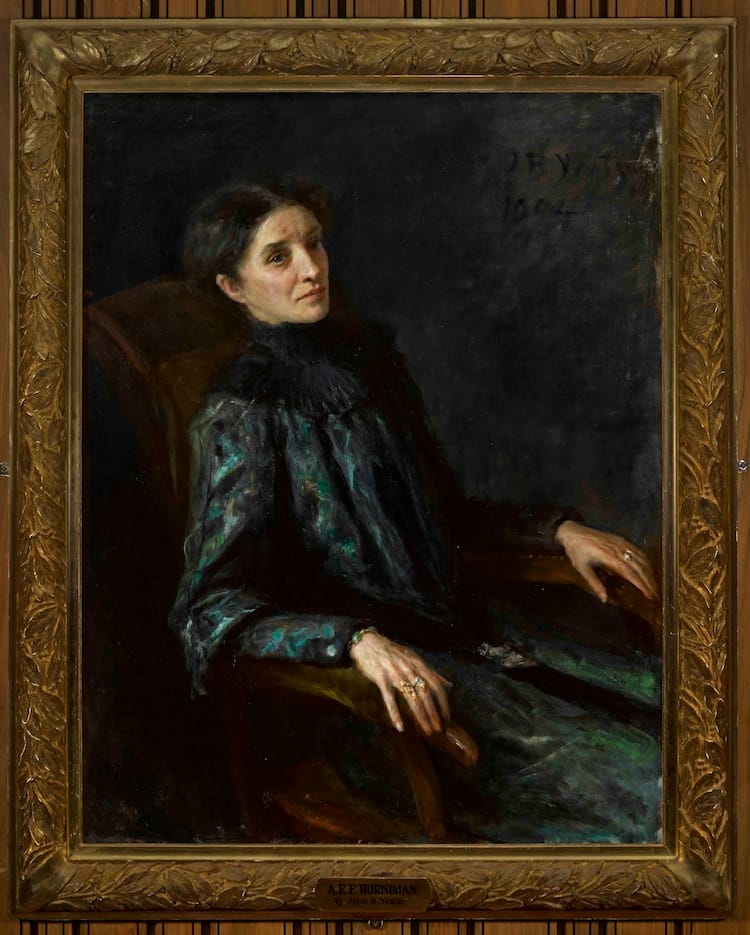What’s the best way to tell area residents about plans for a new asylum shelter nearby?
The government should tell communities directly about plans for new asylum shelters, some activists and politicians say.
The Abbey Theatre has quite an art collection, but archivist Mairead Delaney likes to highlight one in particular: the portrait of Annie Horniman.

Annie Horniman had delicate hands. Or rather, she does in the portrait that you can see hanging upstairs on the wall of the Abbey Theatre.
They’re poised and dainty and adorned with gold rings and, all in all, seem to have gotten far more attention than other hands in the room painted by artist John Butler Yeats.
Those of Máire Nic Shiubhlaigh and brothers Frank and Willie Fay are fuzzier. “They look less and less finished,” says Mairead Delaney, archivist at the Abbey Theatre.
She has her theory for that. It was in April 1904 that Annie Horniman, an English heir to a tea-company fortune, consulted her tarot cards, checked her shares in the Hudson’s Bay Company, and committed to bankrolling the new Abbey Theatre. It opened in December.
“It’s quite a tight time to get a lease, get a renovation done, and gets the paintings,” says Delaney. ”So I think that’s the reason behind it.”
Horniman’s portrait – which shows her sat in a tall-backed chair in what look like rich robes, with an expression frozen somewhere between stern and sad – would probably have been a priority for the painter because, well, she was the one paying.

Delaney tries to point out Horniman’s painting to visitors to make sure that she gets the credit she deserves for stumping up the money for the theatre, she said. “Without her we wouldn’t have an art collection. That’s why I thought she is fundamental to our story. She’s also fundamental to the Abbey Theatre’s foundation,” she said.
Horniman took out the lease on the building, the old Mechanics’ Institute, which had fallen empty after it failed fire regulations. And the lease on the building next door.
Why she went to these lengths and invested in Dublin is an area of speculation. “I think, secretly, there’s an admiration for WB Yeats. I think that’s what’s really behind it but it’s never really been spelt out,” said Delaney.
Horniman had been the secret patron of WB Yeats for some time. Secret, because she was from a Quaker family and “it wouldn’t have been seemly for her family to be indulging in the theatrical arts,” said Delaney.
In 1903, he invited her to Dublin to do costume design for one of his plays. The Irish Literary Theatre experiment – founded by WB Yeats, Lady Gregory and Edward Martyn to stage Irish plays by Irish authors – had been going a few years, putting on shows at different halls around Dublin.
WB Yeats’s invitation was kind of cunning. He knew at this point that she had money, and when he went out on stage after the play and said he wanted to put it on a more permanent footing, she was there to hear it.
Horniman took out the lease, but she couldn’t get the patent that the theatre needed in her name. She wasn’t an Irish resident. So, it was in Lady Gregory’s name.
“So that’s how she’s kind of written out of the scenario because the patent and the official documents were in Lady Gregory’s name,” she said. “So, I’m always kind of harking back to her.”
When the Abbey Theatre first opened in December 1904, the portrait of Annie Horniman – and the three others – hung in the vestibule which also held the booking office and cloakrooms. “Those four are still here on display, I like to keep them out,” Delaney said.
While the portrait of Horniman is the most defined and finished, it’s arguably not the warmest depiction. As NUI Galway Professor Adrian Frazier points out, the artist had called her “fatiguing” in his letters, because she riffed on the sins of the Irish and frequently threatened to cut funding.
That threat would finally be realised in 1910, when Horniman fell out with the folk at the Abbey Theatre.
Lennox Robinson, the young theatre manager at the time, had failed in her eyes to show sufficient respect when King Edward VII died; he’d puts on a play anyway that day.
“She deems this to be a political act, and her subsidy will now cease,” said Delaney, although Horniman was likely winding down her involvement anyway after she bought the Gaiety Theatre in Manchester in 1908.
If Horniman had invested in the Abbey Theatre as a way to woo WB Yeats, it didn’t work. When she offered him the reins of the Gaiety, he turned her down.
If you’re interested in the Abbey Theatre’s art collection, its backstage tours startfrom the Abbey Theatre foyer at 4pm Wednesday to Friday and 11.30am on Saturdays, subject to backstage access. Tickets cost €8 per person / €6 per person for groups of 6–12 people.
Get our latest headlines in one of them, and recommendations for things to do in Dublin in the other.